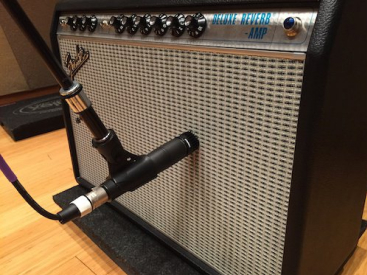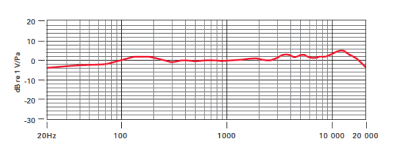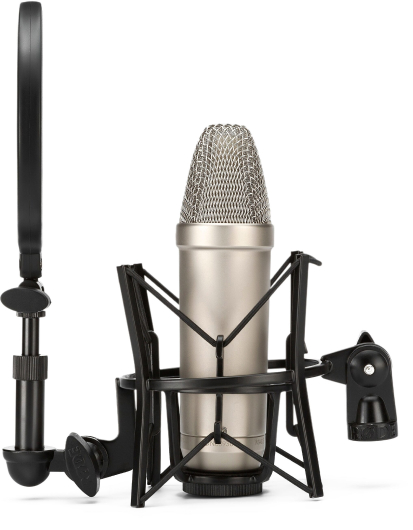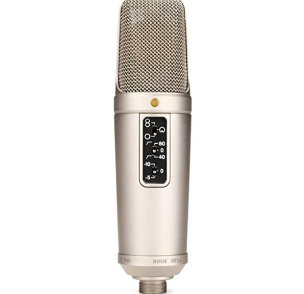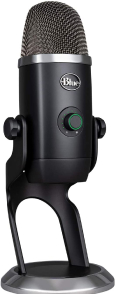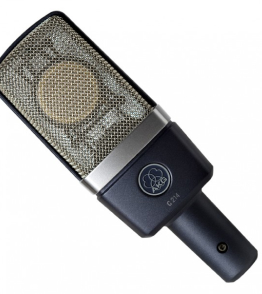The Rode NT1-A Condenser Microphone Review
Mar 13, 2023
In this post, I will do a review of the Rode NT1-A condenser microphone. At the end of the review, I’ll also add some comparison alternatives for the Rode NT1A that are a bit cheaper if you're looking form something more economical.
I have a soft spot in my heart for the Rode NT1-A because it was my very first condenser mic. However, I will make this review unbiased and objective as I can. I would like to structure the review in these different areas:
- Overview of the Rode NT1-A
- Benefits and Advantages of the Rode NT1-A
- Disadvantages of the Rode NT1-A
- Build Quality of the Rode NT1-A
- Alternatives to the Rode NT1-A
- Who I Think The Rode NT1-A Is Best For
Overview of the Rode NT-1A
The Rode NT1-A is a large diaphragm condenser microphone. What does that mean? Well, it essentially looks like this:
Condenser microphones are commonly used for studio recordings. For example, lead vocals, background harmonies, acoustic guitars, drums, or pianos. However, just like anything in music production, there are no rules. Only guidelines.
You can record anything with the Rode NT1-A and that’s why I love it so much. However, there are some times when you might want to use a dynamic microphone over a condenser microphone.
If you plan to be a music producer for the long haul then I recommend having both of these types of microphones in your arsenal: dynamic and condenser.
Skip ahead a little bit and we’ll do dive deeper into the overview. However, if you want to know that difference between condenser and dynamic microphones, then I’l answer your question here.
What is the difference between condenser and dynamic microphones?
You can think of condenser microphones as being more sensitive than dynamic microphones and they are known to produce a higher quality of sound. Condenser microphone, like the Rode Nt1-A, work by converting sound the audio waves into an electrical current using a capacitor.
This is all super technical jargon though. The important tithing to note here is that they require an external power source. You may or may not have heard of phantom power before?
It has nothing to do with the phantom of the opera or musical theatre. This is pure power that is usually supplied by your audio interface. These microphones have the ability to capture a wide range of frequencies because of their sensitivity.
On the other hand, dynamic microphones are less sensitive than condenser microphones. That doesn’t mean it’s bad thing, it actually is a good thing depending on certain situations. Remember when I was saying that it's good to have both dynamic and condenser mics in your studio?
This is because different situations require each. For instance, dynamic mics can handle higher sound pressure levels. Think of a guitar amp. They work by using a wire coil and a magnet to produce an electrical current. Most dynamic mics don’t require an external power source (phantom power) to use the mic.
Ok, now that we have that out of the way, let’s dive back into the review of the Rode NT1-A.
Rode is a trusted company that has been around for many years and you can rest assure that all their products are of high quality. They have been building condenser microphones since the 1990s and have now built themselves as begin one of the go to mic companies for home studios and professional recording studios. The NT1-A microphone could be there most popular condenser mic because of it’s huge popularity. It has managed to built a product that matches price and quality.
If you’re interested in other condenser mics that are of even higher quality from Rode. You can take a look at the Rode NTK or the Rode NT2-A (the bigger sibling of the NT1-A)
Benefits and Advantages of the Rode NT1-A
Low Self Noise
One of the key features of the NT1-A is its low self-noise. You can think of self noise as the literal noise the microphone makes while it’s recording.
Microphones are a bunch of wire and circuits and every microphone will make a bit of noise whether you like it or not. The key benefit to the Rode NT1-A is they’ve managed to make it hardly noticeable. It has a self noise level of only 5 dB. This makes it one of the quietest mics on the market.
Why does having a low self noise matter?
Well, it makes your recordings more clear and it also means that you can record really quiet sounds without having any unwanted hiss or background noise. It definitely makes it a lot easier to not have to worry about removing any background noise.
Frequency Response
The frequency response of the NT1-A is 20 Hz to 20 kH. If you didn’t know, that is the range that humans have. For those technical folks out there, there is a maximum SPL of 137 db. This means that the NT1-A can handle high sound pressure levels without adding any distortion.
Extra Goodies
If you decide to purchase an NT1-A, you’ll also get a shock mount. This is really helpful if you drop or accidentally bump into the microphone. Most condenser mics will have shock mounts because of their sensitivity. Most dynamic mics don’t need shock mounts.
A couple of the other added benefits to the Rode NT1-A purchase is the pop filter, and 20-foot XLR cable. This makes it widely popular for beginner music producers since you get everything in one purchase. I’ll talk more about that in the last section of this post.
Not Just For Musicians
Not just for music producers and songwriters but the Rode NT1-A is also popular among podcasters, and YouTubers. For example, look at my Logic Pro Tutorial video on YouTube. You’ll notice I’m using the Rode NT1-A mic in this video. A lot of my friends who are podcasters also use the Rode NT1-A.
Tone and Character
Let’s talk a bit about tone now. For instance, what’s the overall texture and tone that the Rode NT1-A captures?
Overall, I personally think the tone is quite warm with a natural sound. Which makes it great for multiple purposes. I also think it has a really crisp and clear high end which is why I like it for vocal recordings.
For example, I’ve also recorded my vocals with the Shure SM7B, another industry standard dynamic mic for vocals. However, I find the Shure SM7B is missing some of the crips high end that the Rode NT1-A has. I think the SM7B is great for warmth and tone in the midrange. Where as the Rode NT1-A is full bodied with strong detail and clarity. You can really hear the nuances and detail of a vocal with the Rode NT1-A.
Disadvantages of the Rode NT1-A
Although I might seem like I’m best friends with the Rode NT1-A, we still do have our differences. However, I can say, for me personally, the benefits are greater than the disadvantages.
That’s a good topic to point out. Every person reading this will have a different workflow and reason for purchasing or wanting to use the Rode NT1-A mic.
Do you need it for vocals? You’re making youtube videos? Or you want to record acoustic guitars?
Maybe you just want and all around good mic that can do a good job at recording a bit of everything. It’s important to understand what you need the microphone for, before you go out and buy one.
Harsh Sounds
In the above section when I was writing about the benefits of the Rode NT1-A, I was talking about it’s crisp high end and character. Very good at picking up the nuances of a vocalist. Well, whenever you introduce crisp high end on a microphone, you also introduce the potential for harsh sounding frequencies.
Crispy tone and harsh frequencies are a double-edged sword. With that said, it’s possible to have “crisp” high end without having harsh frequencies but equally you can have harsh frequencies without “crisp” high end. It’s good to mention that, if you’re a beginner music producer and you’re recording vocals in Logic Pro, you might not realize that you’re singing to close to the mic, or perhaps your lyrics have many “s”, or even that you’ve forgotten to use a pop filter.
All of this can introduce harsh frequencies. An experienced producer would understand and make sure to solve these problems before the vocal recording starts. On top of this, there is a lot you can do in post production after you record your vocals. You can eq your vocal to make it more smooth, compress high frequencies, and use a de-esser to control anything harsh that is picked up from the Rode NT1-A.
In my honest opinion, the harsh’ness from the Rode NT1-A isn’t a disadvantage but a benefit. However, I need to mention it because it’s important you understand how to record and capture the crisp high end that comes from the Rode NT1-A and not the harshness.
Rode NT1-A On Mic Functions
Some microphones will come with an on-mic EQ that you can shape the character of the audio before you record. For example, higher end more expensive mics will usually have this function. The Shure SM7B microphone will have this as well as the bigger sibling of the Rode NT1-A which is the Rode NT2-A . Notice the on mic eq with the image below.
Typically, you can add a high pass filter or low cut that will cut any low frequencies. This could be removing any noise or rumble that might be picked up from room noise or even noise coming from outside your studio. For instance, a bus zooming by.
On top of the low cut filter, you can usually do a bump in high frequencies that can add more “air” or “crispness” to the audio recording. This can sometimes sound great when you need a bit more high end on a vocalist that might be too heavy in the mid range.
You’ll notice from the pictures of the Rode NT1-A that there are no dials or buttons to create these filters. That’s because what you see is what you get. The Rode team has created the circuitry in the NT1-A to be well balanced and great for beginners to not have to worry about adding filters before recording.
All in all, simplicity is sometimes great and causes less headaches but on the other hand, reduces your options to shape and create a sound you’re specifically looking for.
Build Quality of the Rode NT1-A
I’ve been impressed with the build quality of the Rode NT1-A considering that I’ve had mine for over 7 years and it’s still a power house. I can’t say I’ve been too careful with it either. I’ve dropped it multiple times and traveled all over the world with it. Still works great! You can see how banged up my Rode NT1-A is in some of my Youtube videos.

The shock mount creates a secure holster for the mic whenever you are recording and you can rest assure that if it does fall off the mic stand, your mic should be okay. I can actually speak from experience. I've dropped my NT1-A over a hundred times and it's still okay. Although, I do feel bad for it.
The actual material of the mic feels strong. Nothing like rough plastic. It's secure metal that will last.
Overall, for the price of the Rode NT1-A, the build quality is superb.
Alternatives To The Rode NT1-A
There are hundreds of alternatives to the Rode NT1-A and that's just because there is such a big market for microphones. To keep things simple though, I'll name a few of my favourite alternatives to the Rode NT1-A that are similar in price and quality.
Audio-Technica AT2035
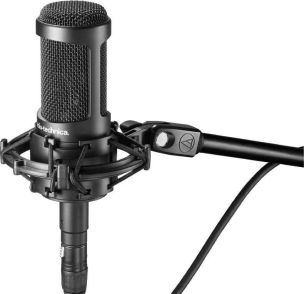
Audio-technica is a great brand for beginners because you’ll notice the price is a bit less than what the Rode NT1-A is listed at. The AT2035 is known for its warmth and natural sound. It’s a great option for recording vocals, acoustic guitar, and other acoustic instruments. I’ve never owned the AT2035 but my friends swear by it as their number one mic for the “all around” work horse.
Blue Yeti
I want to mention the Blue Yeti microphone to give you an option if you’re looking for a condenser mic to record podcasts or even to have a crisp mic to use on your zoom calls. This is a great option because it is USB compatible. Therefore, you don’t need an audio interface.
The microphone offers multiple polar patterns as well and has a built-in headphone jack for monitoring. It’s not only just for podcasters but I’ve seen a lot of songwriters use this too. For instance, I believe Lauv made some of his biggest hit demos on the blue yet.
AKG Pro Audio C214
This mic is more expensive than the Rode NT1-A. However, what you get with the cost is definitely worth the quality. The C214 is similar to the Rode NT1-A in terms of its frequency response and sensitivity but it has higher quality mic parts which allow the recordings to have a slightly warmer sound.
I wouldn’t say it’s noticeable for the beginner ear but if you want to take your first step into higher quality mics for a reasonable price then the C214 would be my suggestion.
Who I Think The Rode NT1-A Is Best For
I won't beat around the bush here. I think the Rode NT1-A is best for music producers within their first 3 years of their production journey.
If you're just starting out then I recommend investing your money into this microphone and learning it inside and out. It will give you a very strong grounding to build on. After about 3 years of use, you should consider adding to your mic collection.
Think about the AKG C214 or even the Neumann TLM-102 or Neumann TLM-103 (which I didn't mention in the post). These are more expensive but you'll notice the increase in quality.
Why not buy those mics right away and skip the Rode NT1-A? True. It's a good question. However, I recommend training your ears on the Rode NT1-A. It's a good idea to have a all purpose mic in the studio like this too. I still toss it into my bag if I'm going to a remote recording or demo session. I don't have to worry about carrying expensive mics around. Buy it, you won't be disappointed.



